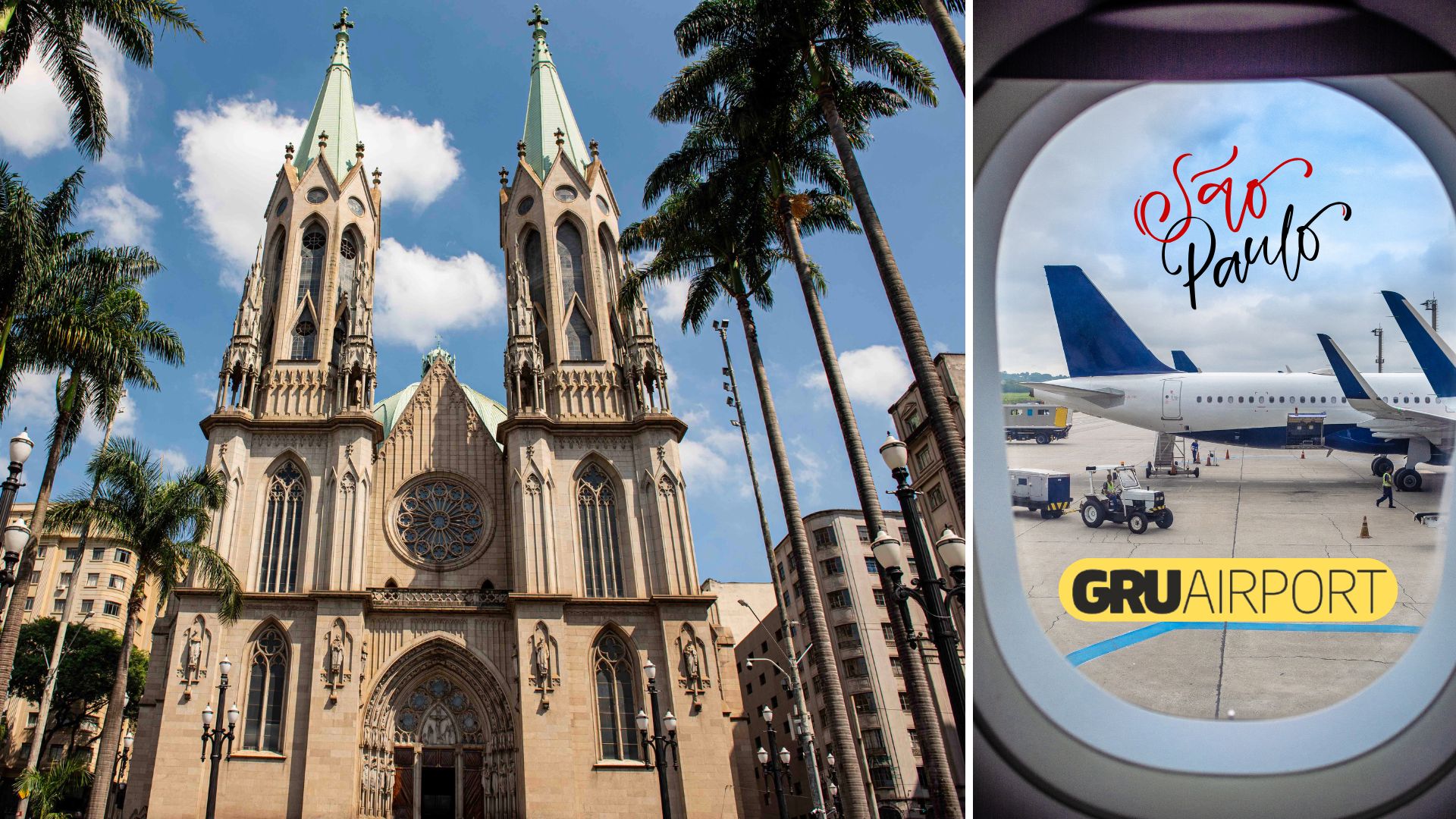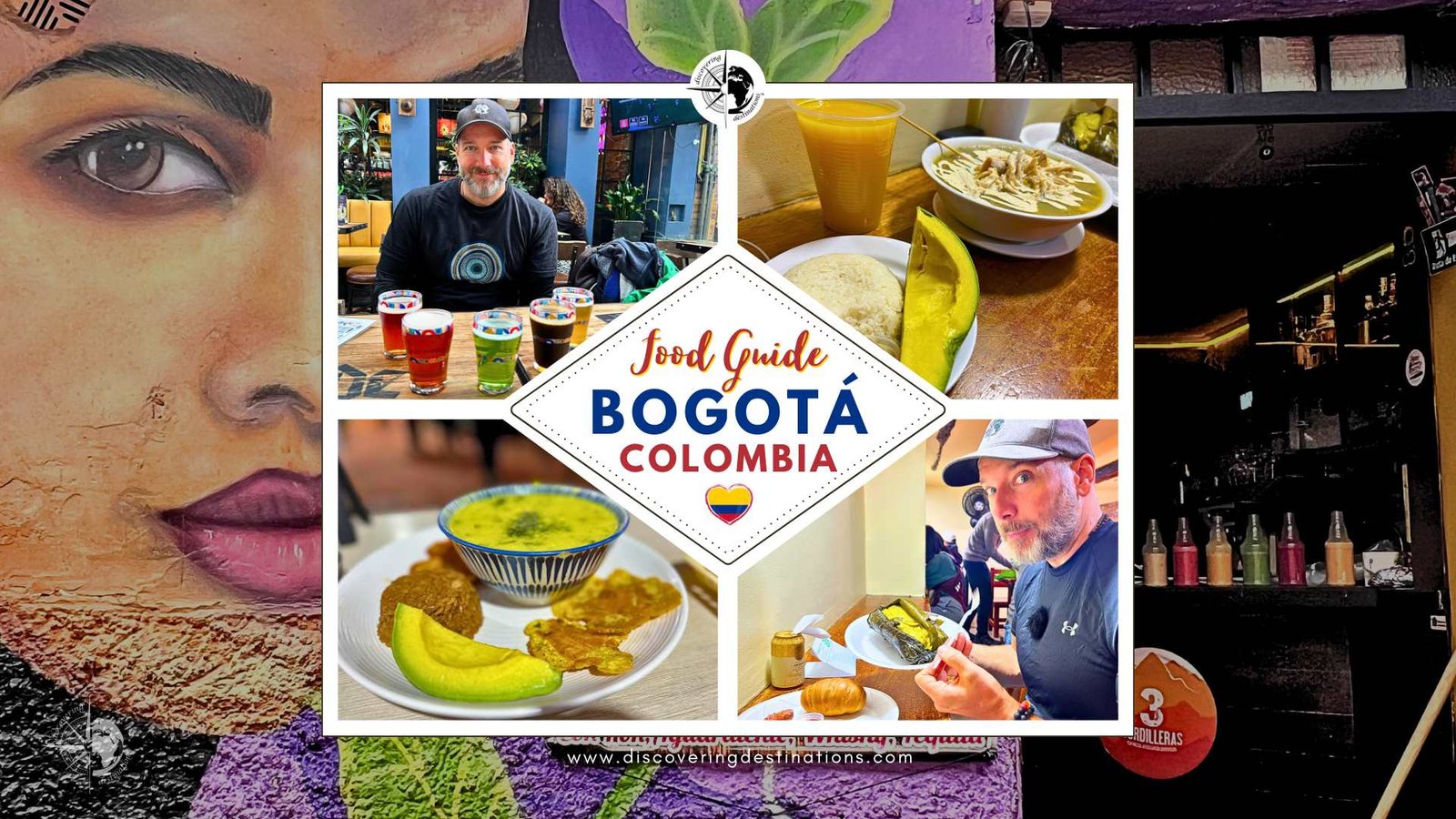Welcome to São Paulo, Brazil! I’m Elisandra Buges (Eli), a Brazilian native, digital marketer, and the voice behind Discovering Destinations, alongside my husband, Serge, who has been traveling to Brazil with me since 2009.
I’ve spent years living and working in São Paulo, Brazil – helping colleagues and traveller’s explore this vibrant city. In this blog, I’ll share my personal insights and practical tips to help you navigate Guarulhos International Airport (GRU) with ease and make the most of your trip to São Paulo.
From visa requirements to transportation tips and safety advice, this guide is packed with everything you need for a smooth arrival.
Don’t forget to check out our travel vlog for even more local insights and inspiration!
DISCLOSURE NOTE: 👉 Our Blog Post contain few affiliate links to products We personally use, trust, and suggest. These help support our efforts in creating valuable and informative content.
When you make a purchase or engage with our affiliate partners through these links, we may earn a small commission at no extra cost to you. Your support enables us to continue producing quality content and exploring new topics. Thank you for being a part of our journey and helping us grow! Sharing is caring ! Click here to learn more.
Table of Contents
Toggle- Before You Travel: Visa Requirements
- After Your Visa: Preparing for Brazil
- Arriving at Guarulhos International Airport (GRU)
- Transportation Options: Getting from Guarulhos Airport (GRU) to São Paulo city
- Driving in São Paulo: What You Need to Know
- Staying Connected: Internet in Brazil
- Holafly eSIM – Great for Longer Stays or Unlimited Data
- Essential Tips for Your Stay in São Paulo, Brazil
- Explore São Paulo Safely and Like a Local
- Shopping in São Paulo, Brazil
- Weather in São Paulo and Packing List tips
- Conclusion
- Discovering Destinations: Travel Tools & Planning Tips
Before You Travel: Visa Requirements
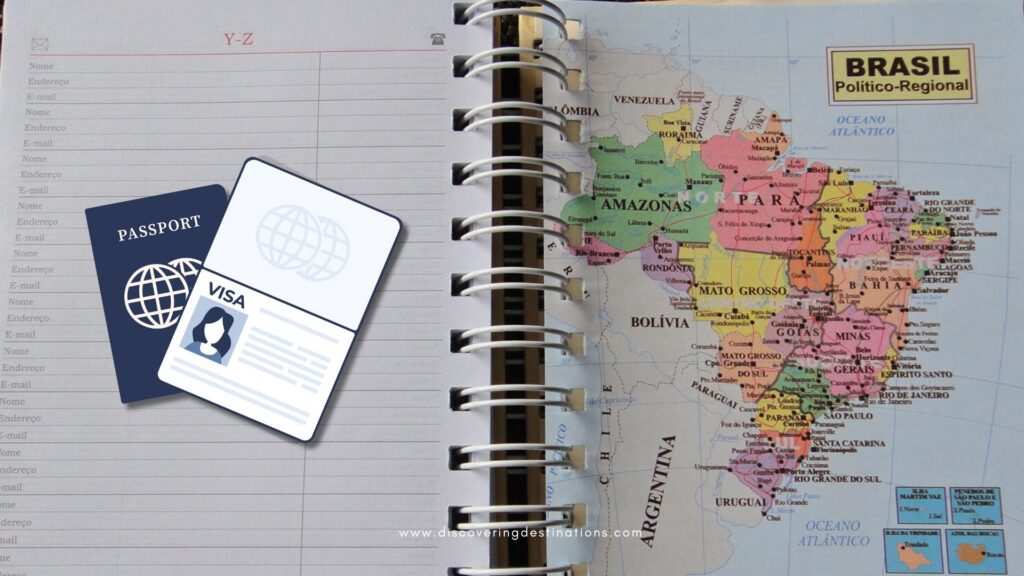
One of the first questions travelers often ask is whether they need a visa to enter Brazil.
Our suggestion is to get in touch with the Brazilian Consulate in your city or country directly to confirm the latest requirements.
You can also visit the official Brazilian government website – Clicking Here for further details and updates.
Since Serge is Canadian and requires a visa to enter Brazil, we recently checked the current guidelines, and here’s the most up-to-date information as of November 2024:
Do You Need a Visa?
- As of April 10, 2025, travelers from Australia, Canada, and the United States must obtain an electronic visa (e-Visa) before entering Brazil.
The e-Visa includes:
- Multiple entries valid for up to five years
- Stays of up to 90 days per visit
Traveler’s from the United Kingdom, India, and the Philippines currently enjoy visa-free entry for stays of up to 90 days.
⚠️ Important Note: Policies can change quickly. Always check with the Brazilian consulate or official government website before your trip to confirm whether visa-free entry still applies.
Local Tip:
Always double-check your visa requirements before planning your trip. Visit the official e-Visa portal or contact your local Brazilian consulate to ensure you have the latest and most accurate information.
After Your Visa: Preparing for Brazil
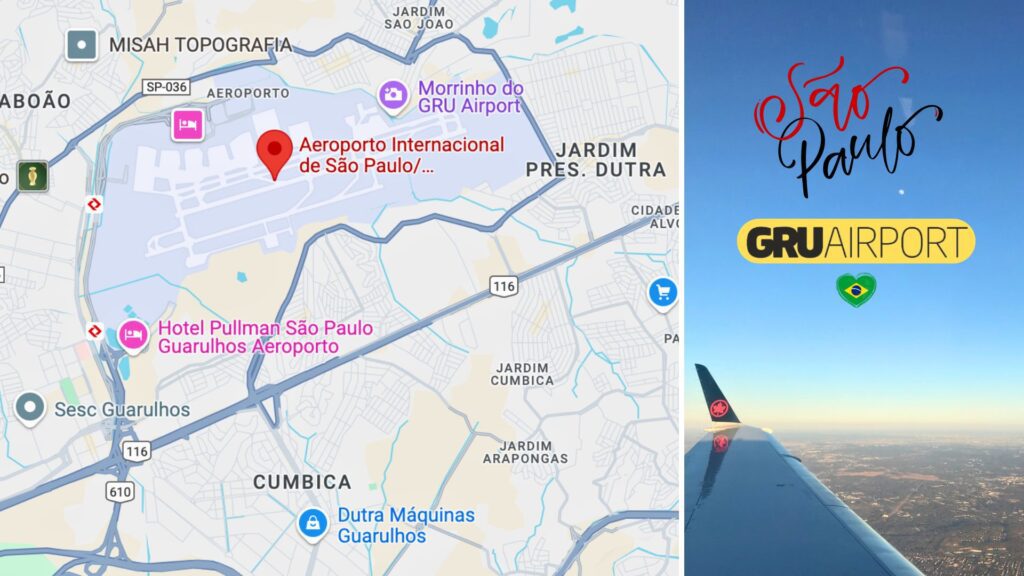
When planning your journey to Brazil, it’s essential to ensure that your luggage complies with the country’s customs regulations. Familiarizing yourself with restricted and prohibited items can save you from unexpected issues at the airport.
Brazil has specific rules on what travelers can and cannot bring into the country. According to the Brazilian Customs Guide, here are some key restrictions:
- Prohibited Items:
- Drugs and narcotics (unless accompanied by a valid prescription).
- Firearms, ammunition, and explosives without proper authorization.
- Counterfeit goods, pirated items, or items violating copyrights.
- Products harmful to health or the environment without authorization.
- Restricted Items (Require Authorization):
- Medicines and health products in large quantities.
- Plants, seeds, and animal products (e.g., food, skins, or leather) that require prior inspection.
- Currency exceeding BRL 10,000 or its equivalent must be declared.
⚠️ Note: When arriving or leaving Brazil, any amount of cash (or equivalent in checks/traveler’s checks) above R$ 10,000 must be declared using Brazil’s electronic customs declaration (e‑DPV). Always verify the latest regulations via Banco Central do Brasil website before your trip.
Important Reminder for Canadian Travelers:
While cannabis and related products are legal in Canada, they remain strictly prohibited in Brazil. Possession of any amount of cannabis, including edibles and other derivatives, can lead to severe legal consequences, such as fines or imprisonment.
- Check Your Belongings: Before departing for Brazil, thoroughly inspect your luggage, carry-on bags, and personal items to ensure they do not contain any cannabis products, including edibles, oils, or infused goods.
- Stay Informed: Familiarize yourself with Brazil’s strict drug laws to avoid unintentional violations.
By diligently checking your belongings and understanding local regulations, you can prevent serious legal issues during your trip to Brazil.
Tip: Always check the official customs website for the latest updates before packing for your trip. If in doubt, leave it out!
By understanding these guidelines, you can ensure a smooth arrival in Brazil and avoid potential fines or confiscations.
Arriving at Guarulhos International Airport (GRU)
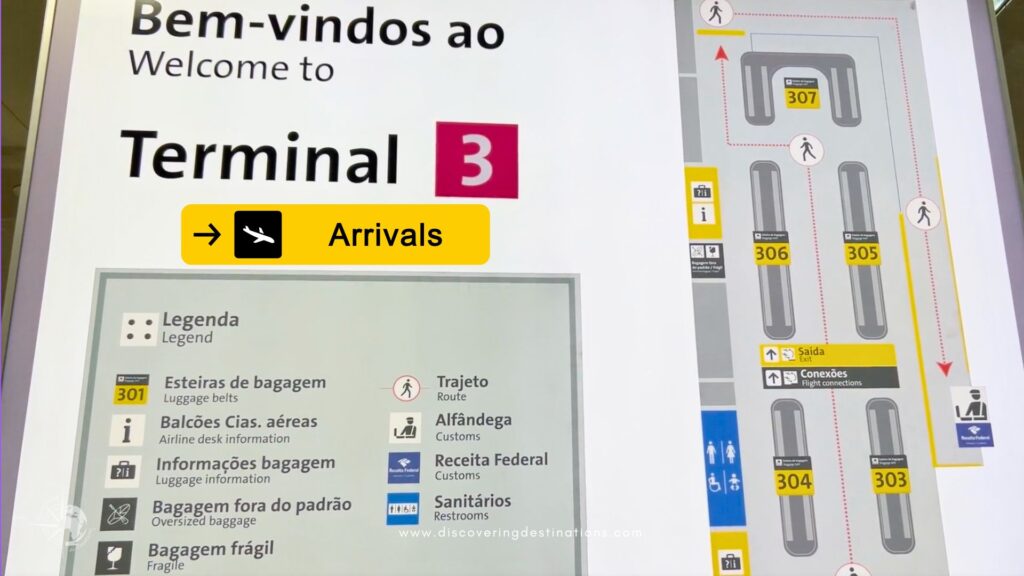
Landing in São Paulo can feel overwhelming if you’re not prepared—but don’t worry, we’ve got you covered!
Having welcomed many friends and colleagues at Guarulhos International Airport (GRU), I (Eli) know the drill and will guide you to navigate your arrival like a seasoned traveler.
Arriving in São Paulo, Brazil – Immigration and Customs
1. Check Your Passport and Visa
Ensure your passport is valid and that you’ve completed all necessary visas or entry forms.
Pro Tip: Double-check your passport’s expiration date! Fun fact: I once had a colleague from Canada who couldn’t pass immigration because his passport had expired—don’t let this happen to you.
2. Dedicated Queue for Foreign Travelers
Upon arrival at Guarulhos Airport, look for the designated queue for international travelers. This is where you’ll go through immigration.
3. Language at Immigration
While some officials speak English (as Serge often experienced), I’ve had friends who were asked questions only in Portuguese.
Tip: If you don’t speak Portuguese, politely clarify by saying, “Eu não falo Português” (I don’t speak Portuguese), so the official knows to proceed in English.
🇧🇷 Learn essential Portuguese before you go! Babbel makes it easy to practice anytime.
Start your lessons today.

4. Have Your Accommodation Address Handy
Whether you’re heading to a hotel, hostel, or staying with friends or family, keep the full address handy for immigration.
📝 Tip: If you’re staying with someone, bring a simple invitation letter with their address and contact info. For business or study purposes, you might need a more formal letter from the company or educational institution.
5. Bring an Invitation Letter (if staying with friends/family)
If you’re not staying at a hotel, it’s helpful to bring a simple invitation letter from the person hosting you in Brazil.
Example: When Serge stays at my family home, I write a short letter that includes the address, my contact details, and a note confirming he’ll be staying with us. It adds peace of mind and can speed up the process at immigration.
✅ Want a copy of our sample invitation letter? Click here to download it for FREE!
Luggage Pickup
After clearing immigration, it’s time to collect your checked luggage.
- Look for the baggage carousel number, which will be displayed on screens in the baggage claim area.
- Luggage carts are available for free—there’s no need to pay for them.
- Pro Tip: Be patient if all the carts are in use; they’re very popular and might take a few minutes to free up.
Duty-Free and Airport Shops
Guarulhos Airport offers a variety of duty-free shops, cafes, and stores, but keep this in mind:
- Tip: If you’re not in a rush, wait until you’re in São Paulo to shop or eat. Airport prices can be double or even triple what you’d pay in the city.
- Pro Tip: Save your money for São Paulo’s incredible local dining and shopping spots—you’ll get much better value and a more authentic experience.
By keeping these tips in mind, you’ll ensure a smooth start to your adventure in São Paulo, Brazil!
Transportation Options: Getting from Guarulhos Airport (GRU) to São Paulo city
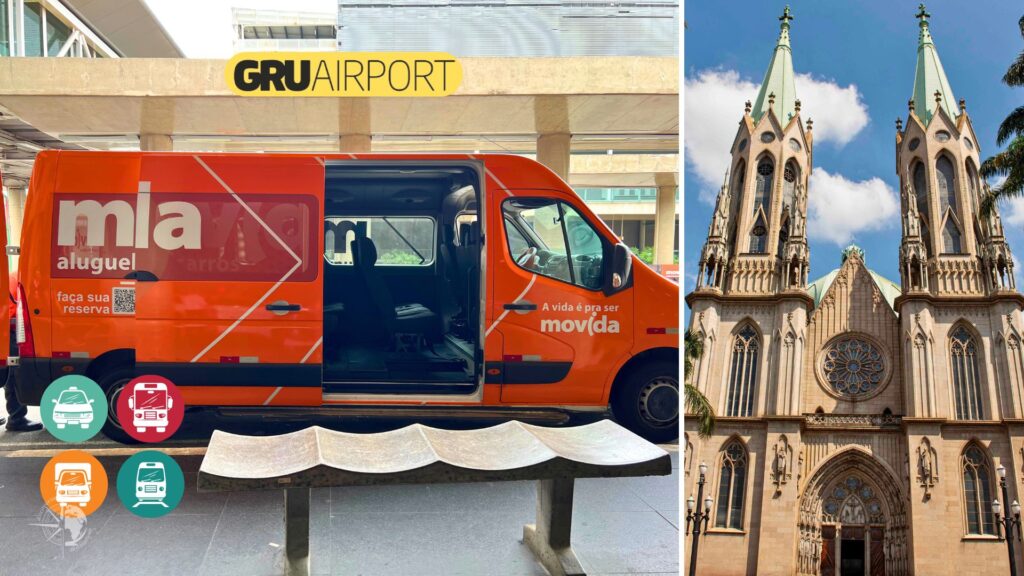
Navigating São Paulo’s traffic can be challenging, especially during rush hours (7–10 AM and 5–8 PM). To alleviate congestion, the city enforces a vehicle restriction policy known as “rodízio veicular.” This system restricts vehicles from circulating in certain areas based on the last digit of their license plates during peak hours:
- Monday: Plates ending in 1 and 2
- Tuesday: Plates ending in 3 and 4
- Wednesday: Plates ending in 5 and 6
- Thursday: Plates ending in 7 and 8
- Friday: Plates ending in 9 and 0
These restrictions apply from 7:00 AM to 10:00 AM and from 5:00 PM to 8:00 PM within the “Centro Expandido” area, which includes major roads and avenues. Violating the rodízio can result in fines and points on your driving license.
Exceptions: Certain vehicles are exempt from these restrictions, including taxis, ambulances, and electric or hybrid vehicles registered in São Paulo. However, exemptions require prior registration with the city’s transport authority.
Note: The rodízio is typically suspended on public holidays and may be lifted during special events or specific periods, such as summer vacations. For the most current information, consult the Companhia de Engenharia de Tráfego (CET) website.
Local Tip: If you’re renting a car, be mindful of these restrictions to avoid fines. Planning your travel outside peak hours or using alternative transportation can help you navigate the city more efficiently.
Transportation Options at Guarulhos airport, São Paulo Brazil:
1. Taxi Services
- Where to Find: Look for official airport taxis at designated taxi stands outside the terminals. These are typically white cars with visible signage.
- What to Expect: Fares are metered, but prices vary based on traffic and time of day. Expect higher rates during rush hours (7–10 AM, 5–8 PM).
- Tips for Taxis:
- Confirm the approximate fare with the driver before starting the trip.
- Avoid unauthorized taxis or individuals offering rides inside the terminal.
- For extra security, ask airport staff to direct you to a reliable taxi service.
2. Ride-Sharing Services
- Apps: While there are several ride-hailing apps available in São Paulo, Brazil, we highly recommend Uber. It is extremely popular, widely used, and considered the most secure option according to locals.
- Benefits: Ride-sharing services like Uber are often cheaper than taxis, especially for longer distances.
- How to Use:
- Open the Uber app upon arrival and request a ride.
- Pay attention to the designated ride-share pickup zones, usually marked with signs at the airport.
- Enable the Security Code feature in your app settings for added safety. You’ll provide this code to your driver to confirm the ride.
- Pro Tip: Always double-check the car’s license plate and driver’s name before getting in to ensure it matches the app details. Personally, I (Eli) always use the Uber security code feature to confirm my ride and feel more secure.
📶 Stay connected in Brazil with an affordable eSIM from Airalo.
Click here to get your digital SIM now.
3. Airport Bus Services
- EMTU Executive Buses:
- These buses provide a more comfortable option for travelers heading to key locations like Paulista Avenue, Tietê Bus Terminal, or Congonhas Airport.
- Tickets can be purchased at counters in the arrivals area.
- Regular Public Buses:
- EMTU Lines 257 and 299 connect the airport to Tatuapé Metro Station (Line 3-Red), offering an affordable way to access São Paulo’s metro system.
- Buses run every 30 minutes, and the journey to Tatuapé takes about 30 minutes.
Click here to find further information about buses itinerary and prices.
Pro Tip: This is a budget-friendly option, but it may not be ideal if you’re carrying a lot of luggage, are unfamiliar with São Paulo, or don’t speak Portuguese. Buses can get crowded, signage is mostly in Portuguese, and understanding where to get off can be tricky without local knowledge.
4. Train Services: CPTM Line 13-Jade
The CPTM Line 13-Jade provides a connection between Guarulhos International Airport (GRU) and São Paulo’s public transport network. While we don’t frequently use this service, we know it’s a cost-effective option for travelers, especially if you’re carrying light luggage.
Key Features of CPTM Line 13-Jade:
- Airport Shuttle: A free shuttle bus connects the airport terminals to the train station (Aeroporto-Guarulhos Station).
- Connections to São Paulo: At Engenheiro Goulart Station, you can transfer to other CPTM or metro lines to reach your final destination.
- Accessibility: This service links Guarulhos Airport to key areas of São Paulo but is better suited for those comfortable navigating public transport systems.
Tips for Train Travel:
- For Light Travelers: The train is ideal if you’re traveling light and don’t mind navigating São Paulo’s extensive public transit system.
- Check the Schedule: Visit the CPTM website to confirm train times and connections before your trip.
- Budget-Friendly: The train is one of the most affordable ways to travel between GRU and São Paulo.
Our Local Insight:
While we often rely on our trusted taxi driver Kazu for rides to and from the airport, we understand that the train is a practical option for many. However, navigating public transport after a long flight or with heavy luggage can be challenging, so consider your comfort level before choosing this option.
If you have specific experiences using the train, we’d love to hear your thoughts in the comments or on our social media!
5. Private Transfers
- Convenience: Pre-booking a private transfer is an excellent choice for comfort and peace of mind, especially after a long flight.
- Platforms to Use: Services like GetYourGuide allow you to book transfers in advance, ensuring a fixed price and reliable service.
- Benefits:
- Great for families, groups, or those with a lot of luggage.
- You’ll be greeted by a driver who will assist with your bags.
- Pro Tip: Check customer reviews on booking platforms to choose the best service.
Choosing the Best Option
Your choice of transportation will depend on your budget, schedule, and comfort preferences:
- Budget-Friendly Options: Public buses and the train system.
- Comfort and Convenience: Ride-sharing apps, private transfers, or EMTU executive buses.
- Peace of Mind: Pre-booked private transfers for fixed pricing and guaranteed reliability.
By knowing your options and planning ahead, you’ll start your São Paulo adventure stress-free and ready to explore!
Driving in São Paulo: What You Need to Know
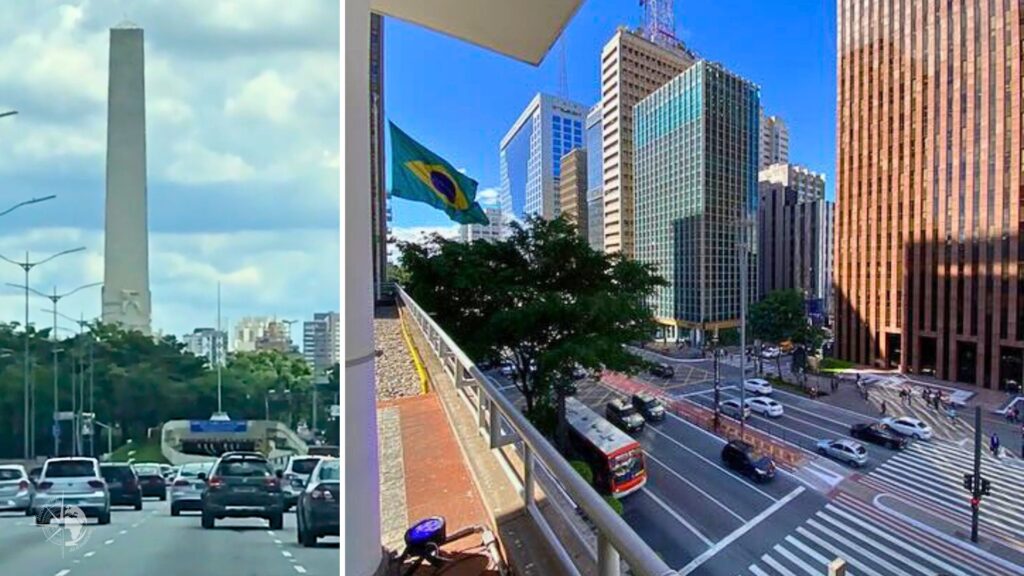
Another great option is to rent a car from Guarulhos Airport and explore São Paulo on your own terms. While driving in São Paulo can feel like an adventure, it’s also a one-of-a-kind experience!
The city’s fast-paced driving culture and unique challenges make it exciting, but it also requires preparation and caution to ensure a smooth and safe journey.
Requirements to Rent a Car:
- A valid driver’s license from your home country.
- Your passport as identification.
- A credit card for the rental.
Local Driving Tips for São Paulo, Brazil:
- Use Navigation Apps: Apps like Waze are essential for real-time directions and radar alerts.
- Be Cautious in Heavy Rain: São Paulo’s tropical climate can cause sudden flooding during downpours. Avoid low-lying areas and seek higher ground if necessary.
- Watch Out for Motorcycles: Delivery motorbikes weave through traffic, especially on busy roads like Marginal Pinheiros—stay vigilant and check your mirrors frequently.
Driving in São Paulo can be a convenient way to explore the city and nearby areas, but it’s essential to stay alert, follow local traffic laws, and plan your routes carefully for a safer experience.
Prioritize Safety While Driving
Keep Windows Closed in Traffic:
In busy areas and when stopped at traffic lights, especially in central or high-traffic zones, it’s best to keep your windows closed. Unfortunately, window-side theft can happen—a phone or bag on the seat might tempt a quick snatch.
Bonus Tip:
Avoid keeping valuables visible inside the car and always lock your doors, even while driving. Trust us—Serge learned this early on while navigating São Paulo!
Mind the Rodízio Vehicle Restrictions
Pay Attention to License Plate Restrictions:
As already mentioned before, if you’re renting a car in São Paulo, it’s essential to remember the city’s rodízio veicular system. Based on the last digit of the car’s license plate, certain vehicles are restricted from driving in central areas during peak hours (7–10 AM and 5–8 PM), Monday to Friday.
Why It Matters:
Violating this rule can result in fines and license points, and yes—it applies even to rental cars. Make sure you plan accordingly or consider public transportation or rideshares during restricted times.
Local Tip:
Before renting, ask the rental company about the plate number and whether the vehicle qualifies for rodízio exemptions. And always check for updates on the CET São Paulo website for the most accurate info.
Note: The rodízio is typically suspended on public holidays and may be lifted during special events or specific periods, such as summer vacations. For the most current information, consult the Companhia de Engenharia de Tráfego (CET) website.
Planning to explore São Paulo by car? Rent your vehicle hassle-free at Guarulhos Airport with RentalCars! Compare prices, choose from trusted providers, and hit the road with confidence.
Book now and start your adventure!
Staying Connected: Internet in Brazil
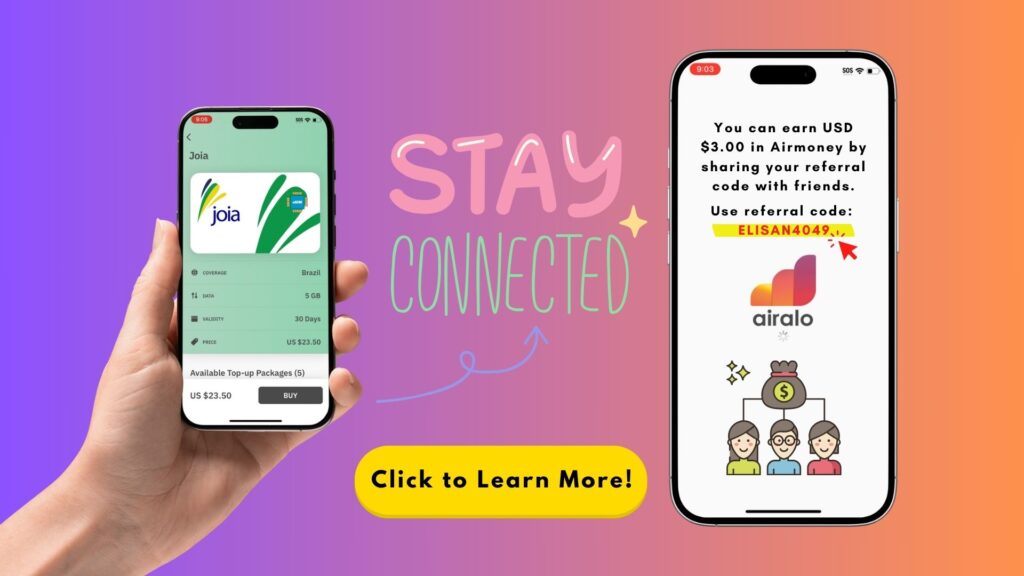
In today’s travel landscape, staying connected is essential—whether for navigation, staying in touch with loved ones, or sharing your adventures online.
Our Top eSIM Recommendations:
Airalo eSIM – Great Value and Flexibility
We’ve personally used and recommend both Airalo and Holafly for Brazil and other parts of South America. Each has unique strengths depending on your travel style and destination.
During our time in Brazil, we’ve been using the Airalo eSIM card, and we absolutely recommend it! It’s convenient, affordable, and works seamlessly, providing reliable coverage across the country.
- Easy Setup: Purchase and activate your eSIM online before your trip, so you’re connected as soon as you arrive.
- Affordable Plans: Choose from a variety of data plans to suit your needs.
- Wide Coverage: Works well across urban and rural areas in Brazil, keeping you connected with essential apps like WhatsApp, Google Maps, and Waze for seamless communication and navigation.
- No Physical SIM Needed: Ideal for travelers who want to avoid the hassle of swapping SIM cards.
- Referral Rewards: Share your Airalo referral code with friends, and you’ll both benefit! Your friend gets a discount, and you earn cashback AirMoney that can be accumulated and used for future trips.

Pro Tip: Take advantage of Airalo’s referral program to save even more on staying connected during your travels! Use our Referral Code: ELISAN4049 at checkout when making your first Airalo purchase, and you’ll receive a cashback of up to CAD $4.50, depending on the current promotion. Start saving and stay connected on your next adventure!
You can also use our promo code on your first Airalo purchase until December 31, 2024 to enjoy even more savings! 🎉
- Promo Code: NEWTOAIRALO15 (Save 15% on your first purchase, valid until the end of the year).
Holafly eSIM – Great for Longer Stays or Unlimited Data
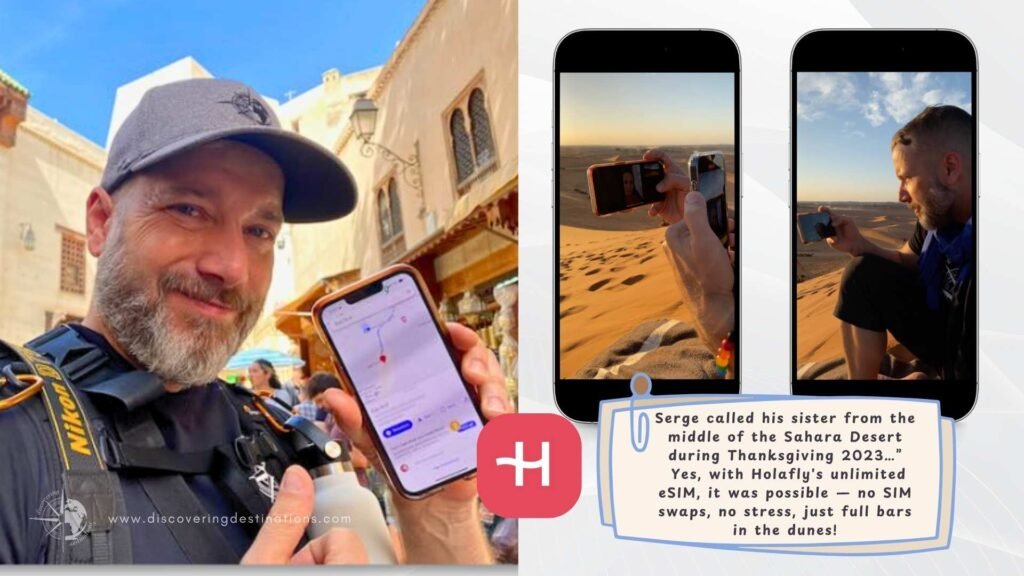
While we used Airalo in Brazil and had a great experience, we recently tried Holafly during our trip to Colombia and found it even more reliable and consistent, especially in remote areas. That’s why we’re planning to use Holafly for our next trip to Brazil too!
Why Consider Holafly?
- Unlimited Data in many destinations, perfect for content creators like us (no need to track usage!)
- Easy Setup – Install the eSIM before your trip and activate when you land
- Excellent Support – 24/7 assistance via WhatsApp (we used it and loved it)
- No Need to Top Up – Just select your number of days and go!
💸 Get 5% Off with Our Link!
As a bonus, you’ll receive 5% off your Holafly eSIM purchase when you book through our affiliate link below 👇
Other Internet Options in São Paulo, Brazil:
If an eSIM isn’t the right choice for you, there are several other options for staying connected while traveling in Brazil:
1. Local Prepaid SIM Cards
- Providers: Major operators include Claro, TIM, Vivo, and Oi.
- Where to Buy: Available at airports, shopping malls, and convenience stores.
- Requirements: Purchasing a prepaid SIM card typically requires a Cadastro de Pessoas Físicas (CPF), Brazil’s national tax identification number. As a tourist, you may not have a CPF, and while some stores might accept a passport, this is not guaranteed and can lead to a lengthy process.
- Considerations: Due to these challenges, obtaining a local SIM card can be complicated for short-term visitors.
2. Hotel or Café Wi-Fi
- Availability: Most hotels, cafes, and restaurants in urban areas offer free Wi-Fi for guests.
- Limitations: Connection speeds can vary, and it’s not a reliable option for navigating on the go.
- Pro Tip: Use a VPN to protect your data when connecting to public Wi-Fi networks.
3. Local Mobile Plans for Long-Term Stays
- Option for Expats or Long-Term Travelers: If you’re staying for an extended period, consider signing up for a local mobile plan with providers like Vivo or Claro.
- Benefits: Unlimited data options and better value for long-term usage.
- Requirements: A local CPF number (Brazilian tax ID) may be required to sign up.
Our Recommendation:
For short-term travelers, the Airalo eSIM card is hands-down the most convenient and efficient option. However, if you’re planning to stay longer or need additional connectivity options, a local prepaid SIM card or pocket Wi-Fi device can also work well.
Stay connected and enjoy exploring Brazil without missing a beat! Let us know in the comments which option works best for you.
Essential Tips for Your Stay in São Paulo, Brazil
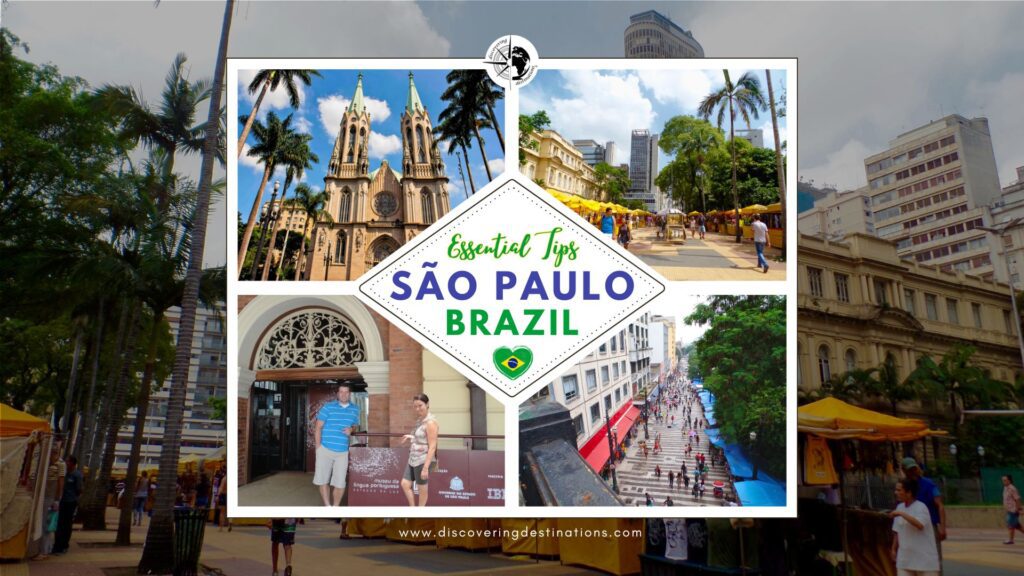
São Paulo is a dynamic city that blends culture, business, and adventure. Whether you’re here for work or leisure, having local tips will make your experience even better.
Language: Yes, we speak Portuguese!
Living outside of Brazil for 15 years is comum people knowing that I am Brazilian start the conversation with “Hola, como estas”? meaning “Hello, how are you” in Spanish.
So, just a little update, the official language in Brazil is Portuguese, and although we love Spanish language, we do not speak Spanish! That’s because Brazil were colonized by Portugal back in 1500. Want to read a bried history of Brazil? Click here.
Now that you know our official language, having key phrases handy will help you in your daily interactions:
- Good morning = Bom dia
- Good afternoon = Boa tarde
- Good night = Boa noite
- Thank you = Obrigado (Male) and Obrigada (Female)
- Please = Por favor
- How much? = Quanto custa?
- Where is … = Onde fica …
- Excuse me / Sorry = Com licença / Desculpa
- Do you speak English? = Você fala inglês?
- The check, please = A conta, por favor
- And, of course, the famous phrase all my friends abroad love: “Please, a caipirinha” = “Por favor, uma caipirinha.”
These phrases will make your interactions smoother and bring a smile to the locals you meet!
Check out Babel.com and start learning Portuguese for your upcoming trip!
Click in the picture to learn more! ⤵️
Currency and Payments in Brazil
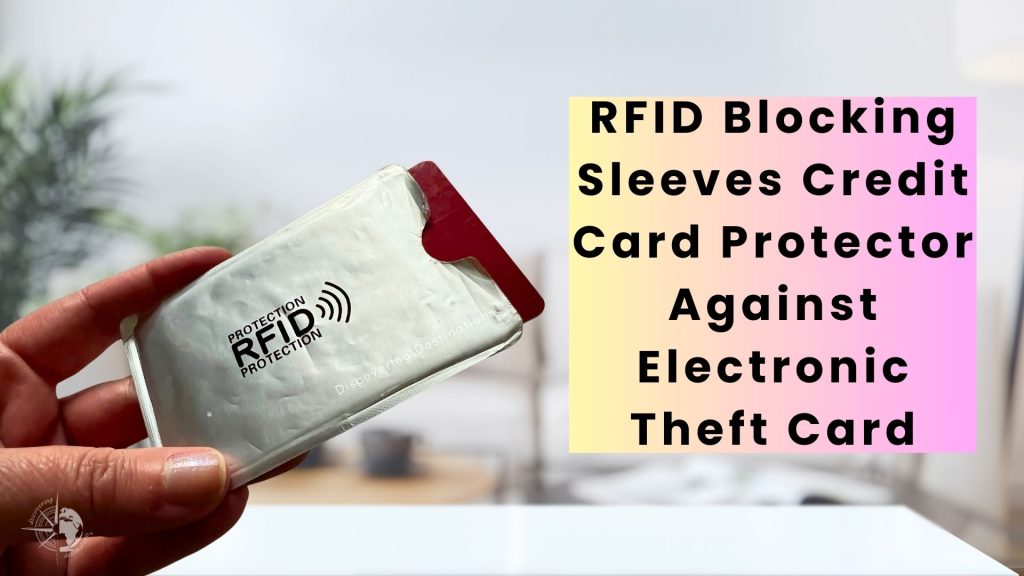
The official currency in Brazil is the Brazilian Real (R$). Whether you’re dining at a fine restaurant, grabbing a coffee, or shopping at a local market, understanding how payments work in Brazil can make your experience seamless.
Key Points About Currency in Brazil:
- Exchange Rates: The value of the Real (R$) fluctuates, so it’s a good idea to check current exchange rates before your trip. Use apps like XE Currency for live updates.
- Cash or Card? While credit and debit cards are widely accepted—even for small purchases—it’s still a good idea to carry some cash, especially when visiting street markets, small shops, or rural areas where card payments might not be available.
- Denominations: Bills in Brazil come in 2, 5, 10, 20, 50, and 100 Real notes, while coins include smaller denominations like 1 Real and cents.
Using Credit Cards in Brazil:
- Acceptance: Credit cards are commonly used for transactions of all sizes, even for a coffee or snacks from a small vendor.
- Popular Networks: Visa and Mastercard are the most widely accepted, with some places also accepting American Express.
- Currency Conversion Fees: Check with your bank about international transaction fees, as some cards may add extra charges for foreign currency transactions.
Pro Tips for Carrying Cash and Making Payments in Brazil
- Carry a Backup Credit Card:
- Keep one card in your wallet and another in a travel belt or safe place. This ensures you’re covered if one card is lost, stolen, or declined.
- Secure Your Cards:
- Consider using RFID-blocking sleeves or Travel Money Belt & Slim Passport Holder RFID Blocking to protect your cards from unauthorized scanning.
- Notify Your Bank:
- Inform your bank of your travel dates to prevent your card from being flagged or blocked for suspicious activity.
- Use ATMs Safely:
- Stick to ATMs inside banks, shopping malls, or well-lit areas. Avoid standalone machines in isolated locations.
- Withdraw cash in reasonable amounts to minimize exposure to theft.
- Carry Small Denominations:
- Vendors may not always have change for large bills (like 100 Real notes), especially in smaller establishments or street markets.
Digital Payments in Brazil:
Brazil has embraced digital payments, and many businesses now accept contactless payment methods such as Google Pay, Apple Pay, or Samsung Pay.
Pix, a widely used instant payment system, is another option but requires a Brazilian bank account.
By planning your payments wisely, you’ll navigate Brazil’s vibrant marketplaces and services with ease while staying secure. Let me know if you’d like any additional details!
Explore São Paulo Safely and Like a Local
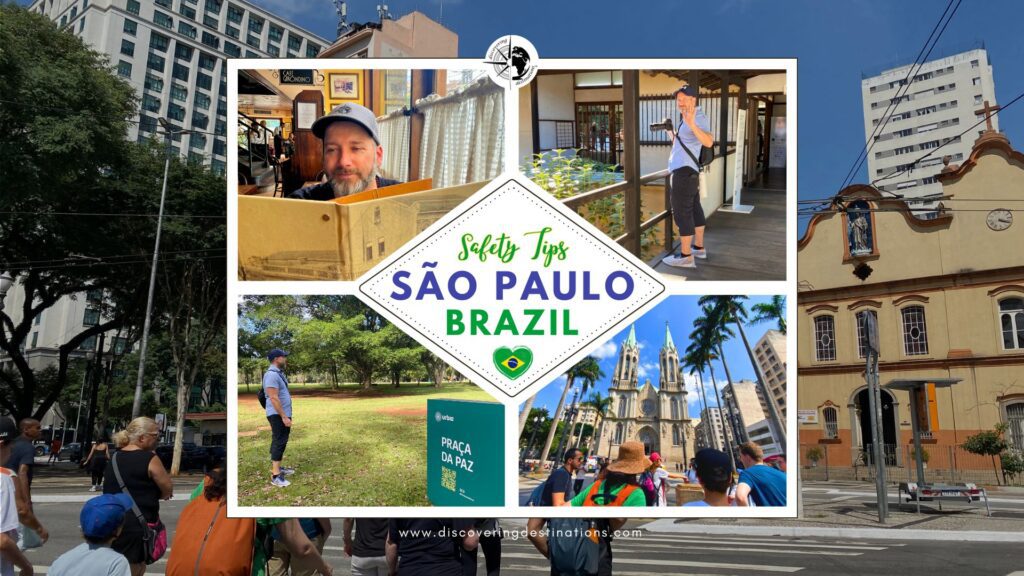
São Paulo offers a vibrant mix of neighborhoods, attractions, and experiences. While the city is full of life, it’s essential to know where to go for a safe and enjoyable visit.
Here are some of our top recommendations for neighborhoods, activities, and safety tips:
Tourist-Friendly Areas in São Paulo, Brazil
- Vila Madalena: Known for its bohemian vibe, colorful street art at Beco do Batman, and lively bars. A must-visit for those looking for a relaxed yet vibrant atmosphere.
- Jardins: Upscale and stylish, Jardins boasts some of São Paulo’s best restaurants, boutiques, and charming streets.
- Itaim Bibi: A modern and sophisticated area filled with excellent dining options, trendy cafes, and a bustling nightlife scene.
- Ibirapuera: Home to the iconic Ibirapuera Park, this area offers a mix of nature, museums, and open-air activities. It’s a great place for walking, cycling, and relaxing amidst greenery, with added attractions like the Museum of Modern Art (MAM) and Afro Brazil Museum.
Our Favorite Must-Visit Spots
- Ibirapuera Park: A sprawling urban oasis perfect for a leisurely walk, a bike ride, or just soaking in nature. It’s a great escape from the city’s hustle and bustle.
- Joaquim Távora Street (Vila Mariana): This vibrant street is packed with bars and offers a friendly nightlife experience. Whether you’re grabbing a drink or enjoying the lively atmosphere, it’s a local favorite.
Exploring Downtown São Paulo Safely
Downtown São Paulo is rich in history and culture, but it’s essential to explore it with caution.
- Guided Walking Tours: Consider joining a guided walking tour to discover the area’s landmarks while staying safe.
- Our Experience: We’ve done a couple of Free Walking Tours in São Paulo and highly recommend them! These tours are not only informative but also a great way to explore with knowledgeable guides who prioritize safety.
Shopping in São Paulo, Brazil
São Paulo is a vibrant city with fantastic shopping opportunities for every budget and style. From bustling markets to luxurious malls, the city has it all!
Best Shopping Areas
- 25 de Março Street:
A paradise for bargain hunters, 25 de Março offers the cheapest shopping options in São Paulo. However, it’s incredibly busy and a hotspot for pickpockets, so stay vigilant and avoid bringing valuables. - Shopping Malls:
São Paulo boasts a wide range of shopping malls that provide a complete experience—like mini-cities under one roof! These malls often feature cinemas, famous brand stores, creative children’s play areas, a variety of restaurants, cafes, and expansive food courts.
Here are some of the most popular shopping malls in São Paulo, Brazil:
- Ibirapuera Shopping: Located near Ibirapuera Park, this mall offers a mix of high-end and mid-range stores, along with great dining options.
- Morumbi Shopping: A stylish mall featuring a variety of international brands and an upscale atmosphere.
- Iguatemi São Paulo: Known for its luxury shopping experience, Iguatemi is perfect for those looking for designer labels and premium stores.
- Shopping Eldorado: A family-friendly mall with a range of shops, entertainment, and dining options.
- JK Iguatemi: A high-end shopping destination that combines luxury brands with sophisticated architecture.
Pro Tip:
If you’re looking for unique Brazilian items like Havaianas sandals or handmade goods, check out local stores and kiosks in these malls for authentic finds.
Whether you’re looking for bargains or luxury, São Paulo’s shopping scene will not disappoint!
Weather in São Paulo and Packing List tips
São Paulo’s weather is known for its unpredictability. Winters are generally mild but humid, while summers are hot with frequent rain showers. Climate patterns have shifted in recent years, meaning you might experience sunshine, rain, and cooler temperatures all in the same day.
Packing Tips for São Paulo, Brazil
To make the most of your trip, pack versatile layers depending on the season and consider the area you plan to visit—São Paulo’s bustling downtown, its scenic countryside, or its beautiful coast (litoral).
For Summer:
- Flip-flops: Havaianas are iconic and perfect for Brazil’s casual vibe.
- Light clothing: Pack breathable fabrics to stay comfortable in the heat.
- Sunscreen: Protect your skin from the strong tropical sun.
- Insect repellent: Essential for outdoor activities, especially to guard against dengue mosquitoes.
For Winter:
- Light jacket: Ideal for cool evenings or overcast days.
- Comfortable shoes: Perfect for walking around São Paulo’s hilly streets.
- Umbrella: or Rain poncho is a must-have for surprise rain showers.
Pro Tip:
If you’re visiting the countryside or coastline of São Paulo, Brazil, be prepared for slightly different weather conditions. The coast can be breezier and more humid, while the countryside may be cooler, especially in the evening. Always check a reliable weather app before packing to tailor your wardrobe to the forecast.
With the right preparation, you’ll be ready to enjoy São Paulo’s diverse attractions no matter the weather!
Conclusion
Congratulations, Discoverers! You’re now equipped to arrive at Guarulhos Airport and start navigating São Paulo, Brazil, like a local. From its vibrant neighborhoods to its delicious cuisine, this city has so much to offer. We invite you to stay tuned as we’ll be sharing more blogs and vlogs about São Paulo and Brazil tourism!
Until then, safe travels and happy discovering!
Did you find this guide helpful? Leave your questions or comments below—we’d love to hear from you!

Lia & Serge from Discovering Destinations
Discovering Destinations: Travel Tools & Planning Tips
Traveling is exciting—but a well-planned trip can make the experience smoother and more affordable. We’ve learned through years of travel that starting early helps you find the best deals, avoid stress, and make the most of your time.
Use trusted tools to compare prices, read real traveler reviews, and book with confidence. From flights and hotels to eSIMs and local tours, these platforms have helped us—and now they can help you too.


